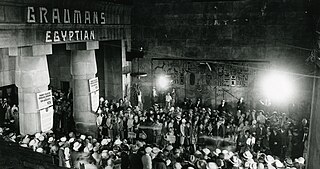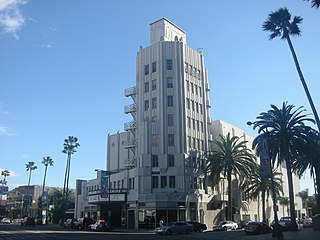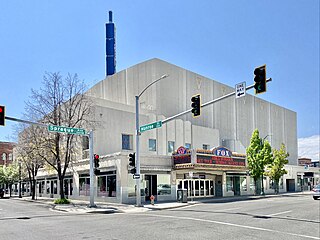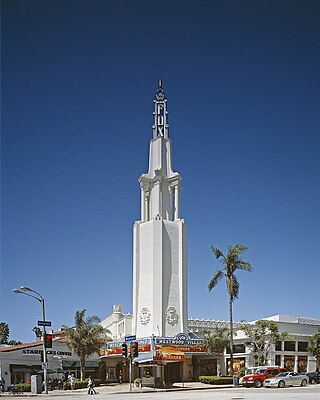Related Research Articles

Toho Co., Ltd. is a Japanese entertainment company that primarily engages in producing and distributing films and exhibiting stage plays. It is headquartered in Chiyoda, Tokyo, and is one of the core companies of the Osaka-based Hankyu Hanshin Toho Group. Toho is best known for producing and distributing many of Ishirō Honda and Eiji Tsuburaya's kaiju and tokusatsu films as well as the films of Akira Kurosawa and the anime of Studio Ghibli, CoMix Wave Films, TMS Entertainment, and OLM, Inc. The company has released the majority of the highest-grossing Japanese films, and through its subsidiaries, is the largest film importer in Japan.

A movie theater or cinema ,also known as a movie house, cinema hall, picture house, picture theater or simply theater, is a business that contains auditoria for viewing films for public entertainment. Most are commercial operations catering to the general public, who attend by purchasing tickets.

Grauman's Egyptian Theatre, also known as Egyptian Hollywood and the Egyptian, is a historic movie theater located on Hollywood Boulevard in Hollywood, Los Angeles, California. Opened in 1922, it is an early example of a lavish movie palace and is noted as having been the site of the world's first film premiere.

Fox Theatres was a large chain of movie theaters in the United States dating from the 1920s either built by Fox Film studio owner William Fox, or subsequently merged in 1929 by Fox with the West Coast Theatres chain, to form the Fox West Coast Theatres chain. Fox West Coast went into bankruptcy and was sold to The National Theatres Corporation, led by Charles Skouras, on November 19, 1934, for $17,000,000.00. Eugene Klein later became CEO of National, and turned it into the conglomerate National General. Mann Theatres bought National General's theatres in 1973.

El Capitan Theatre is a fully restored movie palace at 6838 Hollywood Boulevard in the Hollywood neighborhood in Los Angeles, California, United States. The theater and adjacent Hollywood Masonic Temple are owned by The Walt Disney Company and serve as the venue for a majority of the Walt Disney Studios' film premieres.
Landmark Theatres is a movie theatre chain founded in 1974 in the United States. It was formerly dedicated to exhibiting and marketing independent and foreign films. Landmark consists of 34 theatres with 176 screens in 24 markets. It is known for both its historic and newer, more modern theatres. Helmed by its President, Kevin Holloway, Landmark Theatres is part of Cohen Media Group.

The Ziegfeld Theatre was a single-screen movie theater located at 141 West 54th Street in midtown Manhattan in New York City. It opened in 1969 and closed in 2016. The theater was named in honor of the original Ziegfeld Theatre (1927–1966), which was built by the impresario Florenz Ziegfeld Jr.

The Natural History Museum of Los Angeles County is the largest natural and historical museum in the western United States. The museum is located in Exposition Park, Los Angeles, next to the California Science Center. Its collections include nearly 35 million specimens and artifacts and cover 4.5 billion years of history. This large collection comprises not only of specimens for exhibition, but also vast research collections housed on and offsite.

The Saban Theatre is a historic theatre in Beverly Hills, California, formerly known as the Fox Wilshire Theater. It is an Art Deco structure at the southeast corner of Wilshire Boulevard and Hamilton Drive designed by architect S. Charles Lee and is considered a classic Los Angeles landmark. The building was listed on the National Register of Historic Places on April 3, 2012.

The Pellissier Building and adjoining Wiltern Theatre is a 12-story, 155-foot (47 m) Art Deco landmark at the corner of Wilshire Boulevard and Western Avenue in Los Angeles, California. The entire complex is commonly referred to as the Wiltern Center. Clad in a blue-green glazed architectural terra-cotta tile and situated diagonal to the street corner, the complex is considered one of the finest examples of Art Deco architecture in the United States. The Wiltern building is owned privately, and the Wiltern Theatre is operated by Live Nation's Los Angeles division.

The Fox Oakland Theatre is a 2,800-seat concert hall, a former movie theater, located at 1807 Telegraph Avenue in Downtown Oakland. It originally opened in 1928, running films until 1970. Designed by Weeks and Day, the theatre is listed on the National Register of Historic Places. It was refurbished in the 2000s and reopened as a concert venue on February 5, 2009.

The Fox Theater in Spokane, Washington is a 1931 Art Deco movie theater that now serves as a performing arts venue and home of the Spokane Symphony. It was designed by architect Robert C. Reamer, notable for his design of the Old Faithful Inn in Yellowstone National Park. It was part of the Fox Film Corporation Empire founded by studio mogul William Fox. The theater opened September 3, 1931, and showed films continuously until it closed September 21, 2000, after an engagement of the movie Gladiator starring Russell Crowe.
ArcLight Cinemas was an American movie theater chain that operated from 2002 to 2021. It was owned by The Decurion Corporation, which was also the parent company of Pacific Theatres. The ArcLight chain opened in 2002 as a single theater, the ArcLight Hollywood in Hollywood, Los Angeles, and later expanded to eleven locations in California, Massachusetts, Maryland, and Illinois.

An atmospheric theatre is a type of movie palace design which was popular in the late 1920s. Atmospheric theatres were designed and decorated to evoke the feeling of a particular time and place for patrons, through the use of projectors, architectural elements and ornamentation that evoked a sense of being outdoors. This was intended to make the patron a more active participant in the setting.

The Broadway Theater District in the Historic Core of Downtown Los Angeles is the first and largest historic theater district listed on the National Register of Historic Places (NRHP). With twelve movie palaces located along a six-block stretch of Broadway, it is the only large concentration of movie palaces left in the United States. The same six-block stretch of Broadway, and an adjacent section of Seventh Street, was also the city's retail hub for the first half of the twentieth century, lined with large and small department stores and specialty stores.

The Regency Village Theatre is a historic, landmark cinema in Westwood, Los Angeles, California in the heart of the Mediterranean-themed shopping and cinema precinct, opposite the Fox Bruin Theater, near the University of California, Los Angeles (UCLA). The Regency Theaters chain lease ended in July 2024. The Westwood Village Theatre has been the site for many Hollywood movie premieres in Los Angeles. The seating capacity of the cinema is about 1,400.

The Nimoy Theater, formerly known as Crest, Majestic Crest and Bigfoot Crest Theatre, is a movie theatre located in the Westwood neighborhood of Los Angeles, California. It was founded as the UCLAN in 1941, and was built for live performances but switched to a newsreel cinema during World War II. Through ownership changes, it has been known at various times as UCLAN Theatre, Crest Theatre, and Metro Theatre. The original 500-seat art deco style theater was designed by Arthur W. Hawes.

The Jim Henson Company Lot, formerly A&M Studios, is a studio property located just south of the southeast corner of North La Brea Avenue and Sunset Boulevard in Hollywood. Originally established by film star Charlie Chaplin, the property served as Charlie Chaplin Studios from 1917 to 1953, which later earned the site designation as a Los Angeles Historic-Cultural Monument. After being sold by Chaplin in 1953, the property went through several changes in ownership and has served at various times as Kling Studios, the Red Skelton Studios, the shooting location for the Adventures of Superman and Perry Mason television series. From 1966 to 1999, it was the headquarters for A&M Records and the location of A&M Recording Studios. Since 2000, it has the headquarters of The Jim Henson Company, including the Henson Soundstage and Henson Recording Studios.

The Hayworth Theatre is a theater and performing arts venue at 2511 Wilshire Boulevard located in the Westlake neighborhood of Los Angeles, California.
The Fairfax Theatre is a mixed-use Art Deco style building constructed in 1930. The building is located in Los Angeles' Fairfax District on the northwest corner of Fairfax Ave, and Beverly Blvd. In 2021, the Fairfax Theatre was added to the list of Los Angeles Historic-Cultural Monuments, and declared eligible for the National Register of Historic Places. The building is recognized both for its importance to the Jewish heritage of the Fairfax district as well as for its Art Deco architecture.
References
- ↑ "Toho la Brea Theatre in Los Angeles, CA - Cinema Treasures".
- ↑ "The Modern Theatre". Box Office (May 9, 1960): 37–39.